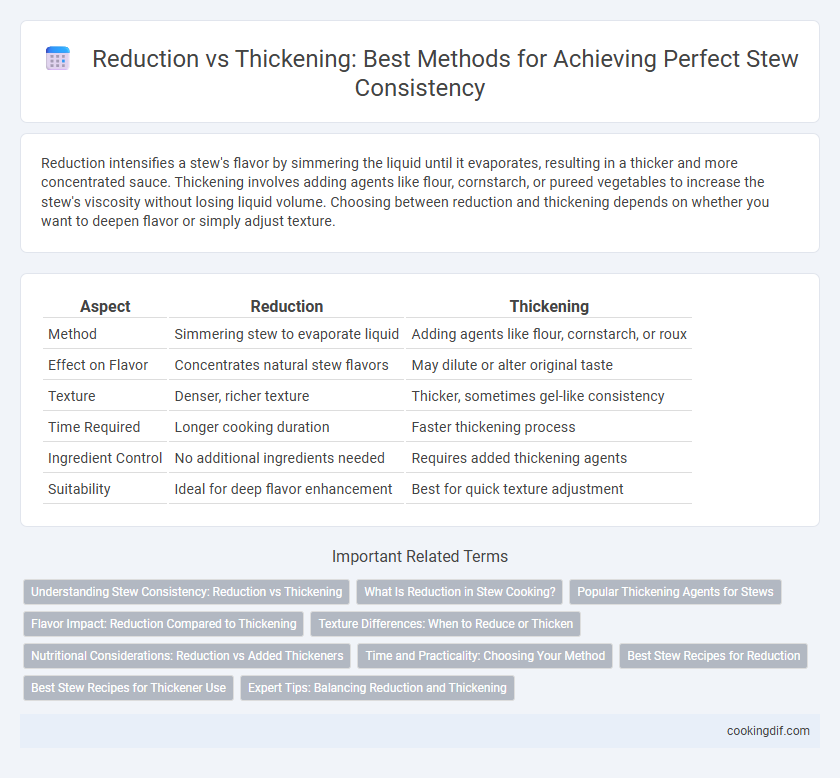Reduction intensifies a stew's flavor by simmering the liquid until it evaporates, resulting in a thicker and more concentrated sauce. Thickening involves adding agents like flour, cornstarch, or pureed vegetables to increase the stew's viscosity without losing liquid volume. Choosing between reduction and thickening depends on whether you want to deepen flavor or simply adjust texture.
Table of Comparison
| Aspect | Reduction | Thickening |
|---|---|---|
| Method | Simmering stew to evaporate liquid | Adding agents like flour, cornstarch, or roux |
| Effect on Flavor | Concentrates natural stew flavors | May dilute or alter original taste |
| Texture | Denser, richer texture | Thicker, sometimes gel-like consistency |
| Time Required | Longer cooking duration | Faster thickening process |
| Ingredient Control | No additional ingredients needed | Requires added thickening agents |
| Suitability | Ideal for deep flavor enhancement | Best for quick texture adjustment |
Understanding Stew Consistency: Reduction vs Thickening
Stew consistency is primarily influenced by two cooking techniques: reduction and thickening. Reduction intensifies flavor by evaporating liquid, concentrating the stew's ingredients, while thickening involves adding agents like flour or cornstarch to increase viscosity without altering volume. Mastery of both methods ensures a perfectly balanced stew, combining robust taste and desired texture.
What Is Reduction in Stew Cooking?
Reduction in stew cooking refers to simmering the liquid over low heat to evaporate water content, concentrating flavors and intensifying the stew's richness. This process naturally thickens the stew as the volume decreases, enabling a more robust and deeply savory consistency without adding extra ingredients. Understanding reduction helps achieve the perfect balance between thickness and flavor depth, transforming a simple stew into a hearty, flavorful dish.
Popular Thickening Agents for Stews
Popular thickening agents for stews include flour, cornstarch, and arrowroot, which effectively increase viscosity without compromising flavor. Flour creates a rich, hearty texture by forming a roux when cooked with fat, while cornstarch offers a glossy finish and requires less cooking time. Arrowroot is ideal for gluten-free stews, providing a clear, gel-like consistency that holds well even at low temperatures.
Flavor Impact: Reduction Compared to Thickening
Reduction intensifies stew flavor by simmering to concentrate natural ingredients, enhancing depth and richness. Thickening agents like flour or cornstarch improve stew texture without altering the flavor profile significantly. Choosing reduction over thickening boosts complex, robust tastes essential for savory stews.
Texture Differences: When to Reduce or Thicken
Reducing stew concentrates flavors by simmering, which naturally thickens the liquid and enhances a rich, velvety texture preferred for hearty dishes. Thickening agents like flour or cornstarch add body without altering flavor intensity, ideal when maintaining moisture but achieving a smooth, glossy consistency. Choose reduction to deepen taste and texture complexity, or thicken for precise control over stew thickness without extended cooking time.
Nutritional Considerations: Reduction vs Added Thickeners
Reduction concentrates flavors and nutrients by evaporating water, enhancing the stew's protein, vitamin, and mineral density without adding extra ingredients. Added thickeners like flour, cornstarch, or cream increase calorie and carbohydrate content, potentially altering the stew's nutritional profile and impacting dietary considerations such as gluten sensitivity or lactose intolerance. Choosing reduction preserves the stew's natural nutritional balance, while thickeners can modify macronutrient ratios and caloric density.
Time and Practicality: Choosing Your Method
Reduction thickens stew by simmering it for extended periods, concentrating flavors and enhancing richness, ideal when time allows for slow cooking. Thickening with agents like flour or cornstarch provides quicker consistency adjustments, suitable for last-minute preparations requiring immediate results. Choosing between reduction and thickening depends on balancing available cooking time with the desired stew texture and depth of flavor.
Best Stew Recipes for Reduction
Reduction enhances stew consistency by simmering the liquid to concentrate flavors and achieve a thicker, richer texture without adding external agents. Best stew recipes for reduction emphasize slow cooking over low heat, allowing water to evaporate gradually while deepening the taste and melding ingredients. This method preserves the natural essence of meat and vegetables, resulting in a robust and hearty stew.
Best Stew Recipes for Thickener Use
Reduction intensifies stew flavors by simmering liquids to concentrate taste, while thickening agents like flour, cornstarch, or arrowroot provide immediate viscosity without long cooking times. Best stew recipes balance both methods to achieve a rich, hearty texture--starting with reduction for depth and finishing with a thickener for smooth consistency. Using natural thickeners such as pureed vegetables enhances flavor complexity and maintains a wholesome profile in the stew.
Expert Tips: Balancing Reduction and Thickening
Achieving the perfect stew consistency requires balancing reduction and thickening methods tailored to the stew's ingredients and cooking time. Expert chefs recommend slow simmering to naturally reduce liquids, concentrating flavors without excessive thickness, while using starch-based thickeners like flour or cornstarch for precise control over texture. Monitoring liquid levels and adjusting heat ensures a rich, velvety consistency that enhances both mouthfeel and flavor intensity.
Reduction vs Thickening for stew consistency Infographic

 cookingdif.com
cookingdif.com